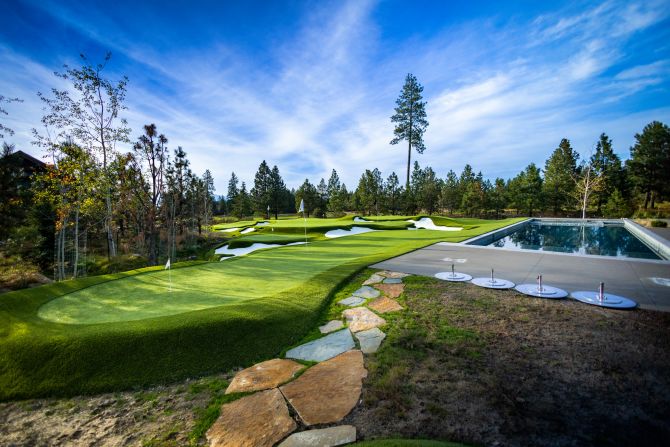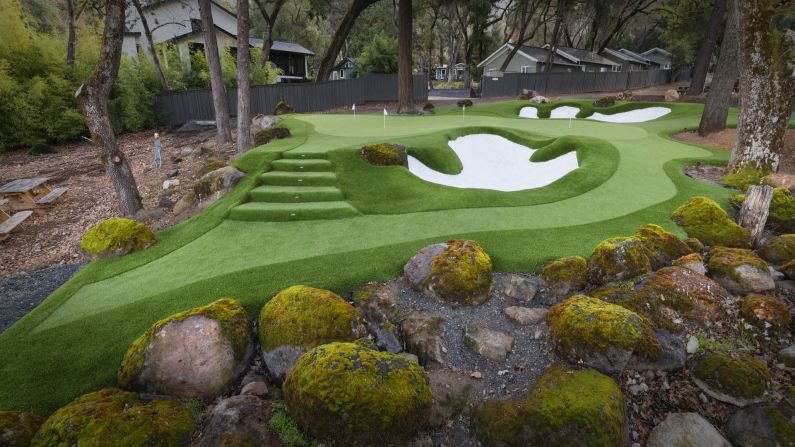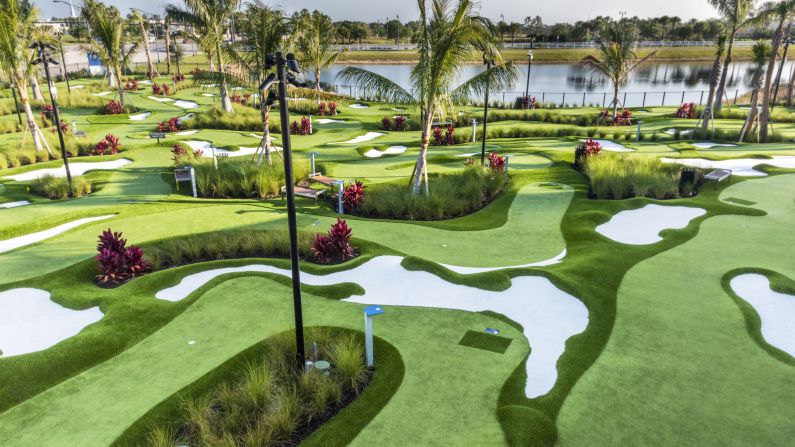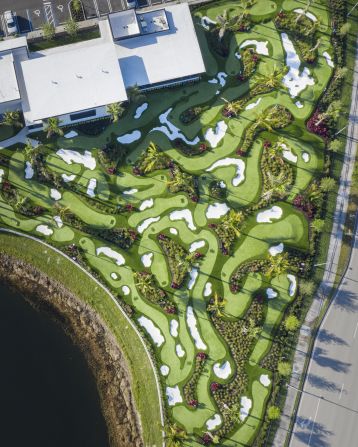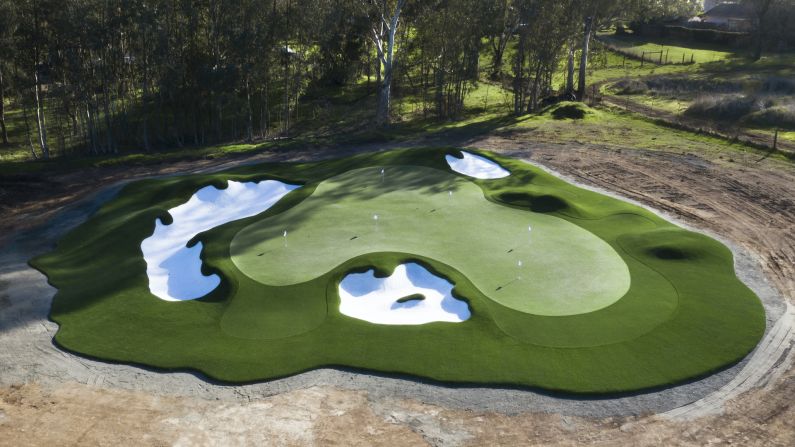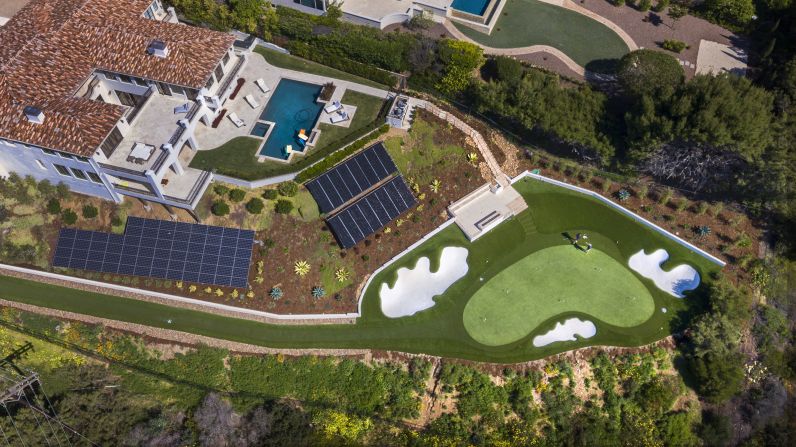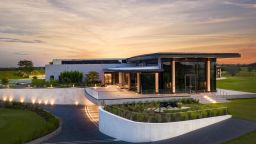What do Mark Wahlberg, Cindy Crawford, DJ Khaled and Josh Allen have in common? All loved golf enough to take it home with them.
From putting greens and par-three holes to full-blown course replicas, the sport is increasingly taking up residence in gardens and backyards as golf enthusiasts of all levels look to shorten their travel time to the tee.
And if it’s at a home in the US, there’s a decent chance the work was sculpted and built by Back Nine Greens, an artificial grass installation company based in Southern California.
Established in 1997, the firm says it has constructed over 10,000 projects across 26 years, the aforementioned quartet headlining a star-studded clientele that has helped the business branch out from its headquarters in Palm Desert to a web of locations across the country.
Business boomed during the Covid-19 pandemic, with homebound golfers desperate to continue playing, but despite the company name, golf is not the dominant revenue stream for Back Nine Greens — it’s grass.
Artificial lawns offer a lower maintenance alternative to the real deal, which is more more vulnerable to the weather and requires regular attention. Bar clearing leaves or other debris, synthetic turf requires comparatively little upkeep and does not need to be watered, a potential deal-sealer in hot locations where the company frequently operates. California in particular is especially prone to drought, with state officials encouraging its citizens to cut their water usage.
As a result of demand, Back Nine Greens’ specialties have extended from backyards to office spaces, playgrounds, pickleball courts and beyond. Yet golf remains its signature style.

Golf art
“People are looking for golf art. They don’t know it, but they are,” explained Back Nine Greens founder and president Dominic Nappi, who claims to be the first in the nation to use white turf instead of sand to create bunkers.
“If we’re watching the British Open or The Masters, we’re in the house and we look out in the backyard — if you could see it, what would you want it to look like?” he added.
“These are beautiful pieces of art, the way I look at it, and they want to buy that art.”
Like fine art, it comes at a price. The cost of a generic artificial green, without bunkers, starts from between $15 and $25 per square foot. With some designs spanning entire lawns — Tim Venturi, son of golf hall of famer Ken Venturi, had a 12,000-square foot green installed at his home — the largest can tally hundreds of thousands of dollars.
Costs can be affected by the state of the chosen ground, with areas dotted by trees, rocks and other obstructions requiring extra work before construction can begin. Yet “the number one” factor that can hike prices for larger greens, Nappi explains, is — ironically — drainage.
Though they don’t require watering, greens sculpted in areas susceptible to heavy rain — such as Florida or Georgia — invite the threat of standing water, which can lead to mold and ruin the playing experience.
The latter is a no-go, because while aesthetics is key, playability is the ultimate goal.
“You can make it look pretty and beautiful and they love it, but it better play right,” Nappi said. “That’s the beauty of it, you can deliver both.”

Star power
And for his most high-profile clients, that delivery comes with an added pressure.
Hired in 2013 to build a five-hole putting paradise for Hollywood actor Wahlberg on his sprawling 30,500-foot Beverly Park estate — a property that went on sale for $87.5 million in April 2022, according to the Los Angeles Times — Nappi spent three nights holed up in a hotel room, trapped in a loop of sketching designs only to scrunch and launch them into the bin.
After calling in support from Tim Jackson — co-founder of golf course design firm Jackson Kahn, which sculpted Arizona’s Scottsdale National — Nappi concocted a 120-yard short game complex for the film star, fit with rolling hills and multiple pitching spots.
“It turned out to be the greatest — and hardest — job I’ve ever done,” Nappi said. “There’s not a better green in the nation than that one. It’s pretty badass.”
Other highlight projects included a putting green for Crawford and her husband Rande Gerber at their Malibu home, another for Bills quarterback Allen at his new house in Buffalo — complete with bunkers that light up as he enters the driveway — and a sweeping putting complex for music producer DJ Khaled at his Miami Beach estate.
Occasionally, clients require something a little more bespoke. Back Nine Greens was called out to enhance golf broadcaster Jim Nantz’s garden replica of Pebble Beach’s iconic seventh hole — at half its original scale.
The seventh is a par-three with special significance to Nantz, who married his wife Courtney Richards on its tee in 2012. A flurry of famous names, including legendary golf duo Jack Nicklaus and Arnold Palmer, have played the garden copy, with the names of those to have made hole-in-ones — such as Phil Mickelson, Ian Poulter and Tony Romo — etched onto a nearby “Rock of Fame.”
A host of other celebrities have sought to transport some of the world’s most famous holes onto their properties. Dubbed “the world’s greatest backyard” by the Wall Street Journal in 2012, American golf coach and former NASA employee Dave Pelz’s garden in Austin, Texas, is a short game paradise. The two-and-a-half-acre site, sculpted by SYNLawn, boasts replicas of the 17th holes at Pebble Beach and TPC Sawgrass (“the island hole”), as well as Augusta National’s legendary par-three 12th.
Copies of the latter two also feature at Welsh football icon Gareth Bale’s property in Glamorgan, South Wales. The former Real Madrid star — long renowned for his golfing prowess — also has a replica of Royal Troon’s “postage stamp” 8th hole. The three-hole circuit was built by UK-based Southwest Greens Construction.
Unsurprisingly, arguably the most high-profile golfer of them all also has his own practice retreat. Tiger Woods partnered with his own TGR Design firm to oversee construction of a 3.5-acre backyard practice facility when he moved into a mansion in Jupiter Island, Florida, in 2010, fit with four greens and an array of bunkers.
Yet for Nappi, perhaps his fondest project was for a buyer without celebrity status: a 63-yard garden par three for an amateur golfer in South Dakota. A month after construction, the client won his local club tournament on a closest-to-the-hole competition following a tie.
The shot distance? Just shy of 63 yards.
“He had hit hundreds of balls [in his garden] and just said, ‘I had it down,’” Nappi recalled.
“It gave me goosebumps to know that through the repetition of the swing, he made that shot from that distance. That’s pretty awesome.”
